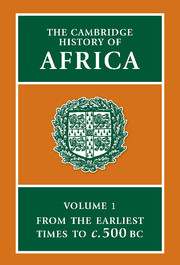Book contents
- Frontmatter
- 1 The palaeo-ecology of the African continent: the physical environment of Africa from earliest geological to Later Stone Age times
- 2 Origins and evolution of African Hominidae
- 3 The earliest archaeological traces
- 4 The cultures of the Middle Palaeolithic/Middle Stone Age
- 5 The Late Palaeolithic and Epi-Palaeolithic of northern Africa
- 6 The Later Stone Age in sub-Saharan Africa
- 7 The rise of civilization in Egypt
- 8 Beginnings of pastoralism and cultivation in north-west Africa and the Sahara: origins of the Berbers
- 9 The origins of indigenous African agriculture
- 10 Old Kingdom, Middle Kingdom and Second Intermediate Period in Egypt
- 11 Early food production in sub-Saharan Africa
- 12 Egypt, 1552–664 BC
- Bibliographical essays
- Bibliography
- Index
- Fig. 3.5 The distribution of sites known or believed to be older than 1.5 million years (i.e. Oldowan). (Modified from J. D. Clark 1967.)
- Fig. 3.6 The distribution of sites known or believed to be between 1.5 and 0.7 million years (i.e. Early Acheulian and Developed Oldowan).">
- Fig. 3.7 The location of Earlier Stone Age and Lower Palaeolithic sites thought to be between 0.7 and 0.1 million years old (i.e. Acheulian plus Developed Oldowan/Hope Fountain).
- Fig. 3.16 The ‘Zinjanthropus’ site at FLK, Bed I, Olduvai Gorge. A plan showing the distribution of an old ground–surface which was uncovered by excavation. A dense patch of discarded artifacts and introduced stones (manuports) coincides with a dense patch of broken–up animal bones. (After M. D. Leakey 1971.)
- Plate Section
- Plate Section
- Plate Section
- Plate Section">
- Plate Section
- Plate Section
- Plate Section
Bibliographical essays
Published online by Cambridge University Press: 28 March 2008
- Frontmatter
- 1 The palaeo-ecology of the African continent: the physical environment of Africa from earliest geological to Later Stone Age times
- 2 Origins and evolution of African Hominidae
- 3 The earliest archaeological traces
- 4 The cultures of the Middle Palaeolithic/Middle Stone Age
- 5 The Late Palaeolithic and Epi-Palaeolithic of northern Africa
- 6 The Later Stone Age in sub-Saharan Africa
- 7 The rise of civilization in Egypt
- 8 Beginnings of pastoralism and cultivation in north-west Africa and the Sahara: origins of the Berbers
- 9 The origins of indigenous African agriculture
- 10 Old Kingdom, Middle Kingdom and Second Intermediate Period in Egypt
- 11 Early food production in sub-Saharan Africa
- 12 Egypt, 1552–664 BC
- Bibliographical essays
- Bibliography
- Index
- Fig. 3.5 The distribution of sites known or believed to be older than 1.5 million years (i.e. Oldowan). (Modified from J. D. Clark 1967.)
- Fig. 3.6 The distribution of sites known or believed to be between 1.5 and 0.7 million years (i.e. Early Acheulian and Developed Oldowan).">
- Fig. 3.7 The location of Earlier Stone Age and Lower Palaeolithic sites thought to be between 0.7 and 0.1 million years old (i.e. Acheulian plus Developed Oldowan/Hope Fountain).
- Fig. 3.16 The ‘Zinjanthropus’ site at FLK, Bed I, Olduvai Gorge. A plan showing the distribution of an old ground–surface which was uncovered by excavation. A dense patch of discarded artifacts and introduced stones (manuports) coincides with a dense patch of broken–up animal bones. (After M. D. Leakey 1971.)
- Plate Section
- Plate Section
- Plate Section
- Plate Section">
- Plate Section
- Plate Section
- Plate Section
Summary
THE PALAEO-ECOLOGY OF THE AFRICAN CONTINENT
Although the ancient Egyptians explored the northern part of Africa and traded with West Africa, knowledge of the interior of the continent was scanty. The Greek school at Alexandria gathered important records and it was there that Eratosthenes, about 2000 BC, made the first scientific measurement of the circumference of the earth. It was also in Alexandria that Ptolemy, around AD 150, developed his famous map of the known world, although it has survived only in Arabic and mediaeval versions of his Geographia. Ptolemy's map served as the base for the Arab explorers of the seventh to fourteenth centuries and was modified during the fifteenth and sixteenth centuries as the whole southern coastline became defined. However, details shown in the interior in these early maps are highly speculative and it was not until the middle of the last century that scientific exploration began to reveal a true picture of the interior. The growth of cartography is conveniently considered in Tooley and Bricker (1969) and the progress of exploration presented in maps by Fage (1963). Even in the final decades of the nineteenth century, large areas of the continent were almost unknown and in his classic Das Antlitz der Erde Suess (1885—1901) drew heavily on travellers' reports for the geology of some portions of the continent and had to omit many regions for lack of data. The first government geological survey was only established in 1895 (at the Cape), but mineral exploration led to rapid growth of geological knowledge and the 1920s saw the appearance of several important regional studies, such as Gregory (1921) on East Africa and the rift valleys, du Toit (1926) on South Africa, and the first systematic geology of the whole continent by Krenkel (1925, 1928).
- Type
- Chapter
- Information
- The Cambridge History of Africa , pp. 941 - 970Publisher: Cambridge University PressPrint publication year: 1982



